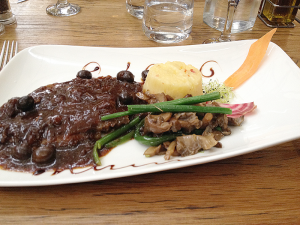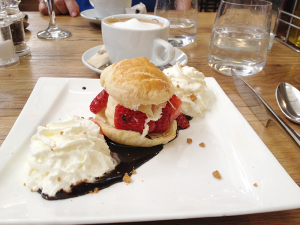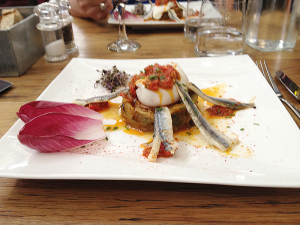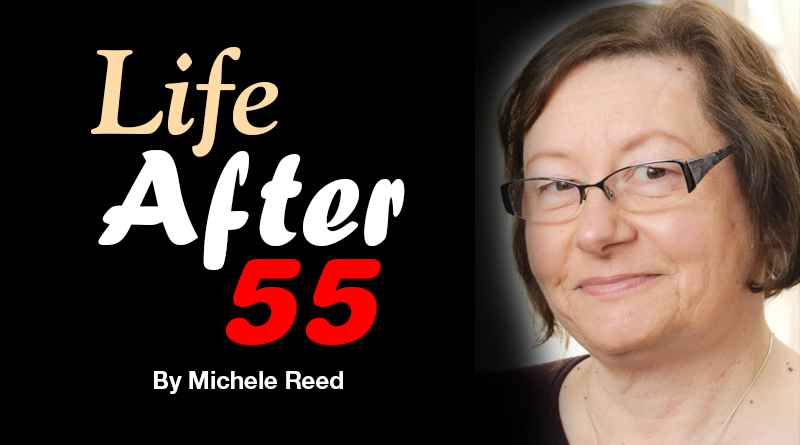Sharing the Good Food of France
By Michele Reed
michele@cny55.com

There’s nothing more important to the French than sharing food. Even on TV commercials, most ads for food start with the word “partager” (part – ah – zhay) — literally, to share.
We Americans are used to taking short or non-existent lunch breaks, often eating at our desks, packing a sandwich and an apple or protein drink in a paper sack. Our French neighbors would be horrified by this. Most businesses close completely from noon or 12:30 until 2 or 2:30 p.m., so the workers can get lunch. Sometimes they go home to their families, with parents picking up their kids at school and taking them home for a family meal. Other times, the workers eat together, either on site like a potluck or out in neighborhood restaurants.
And eating lunch at those restaurants is not a fast food affair — although there are fast food joints. Even McDonald’s is in France. The French people shorten it to McDo, pronounced Mc Dough. Their hamburgers are made of French beef and ads inform you of the breed of cow and what region of France it came from. Cheeseburgers are made with Brie, Gruyere or Emmenthaler, a type of Swiss cheese, and have names like “The Shepherd” or “The Mountaineer.”
The real French noon meal is usually a three-course affair with an aperitif, usually a rosé wine or Kir, a drink made of white wine and crème de cassis. Lunch itself is accompanied by a carafe of red wine as well as water.
We had a beautiful lunch at one of our favorite restaurants. Hallegria is so named because it is located in Les Halles, or the grand covered market in Beziers. Most French cities have halles, literally, the halls. The covered markets became popular when the landscape became more urbanized in the 19th century, and are huge structures of wrought iron, wood and glass. Hallegria’s claim to fame is that they use only fresh ingredients from that day’s market, changing the menu to fit what is available. Most ingredients are local and all are as fresh as can be.
The French don’t pronounce the letter H so the name of the restaurant is a pun on the Italian word allegria, meaning liveliness. A sports bar founded by a group of friends and former athletes each active in the food business in one way or another, it is our favorite place to watch a rugby game on Saturday afternoon or have a special lunch midweek.
We recently learned that the owner we know best — we frequent his other café in town, too — is a former rugby hero of Beziers, who is a four-time champion of France. Those are his rugby boots and jersey hanging on the wall. And to think, I thought they were only artful decorations!
Every restaurant offers the “formula,” or menu of the day. You can choose from an entrée, which unlike the English word actually means the first course or starter; the plat du jour, which is the main dish of the meal; and dessert. You can usually choose any combination of the three. I always opt for the entire meal because I love sweets, but Bill, my husband, is a much more careful eater and will forego dessert, choosing only entrée and plat.

Our entrée was a soft poached egg over a mélange of vegetables including eggplant, lentils, onions and tomato, beautifully molded in the center of the plate. A spicy tomato sauce bathed the whole creation and it was flanked by six tiny marinated anchovies. Garnish included beet sprouts and pink endive.
The plat du jour was pot roast — but this was not your grandma’s pot roast! Two succulent, tender slices of slow-braised beef chuck were smothered in a rich, dark sauce. We could taste hints of wine, raisins and onions. An artful scoop of potatoes whipped with butter and bits of bacon accompanied it, and the vegetable portion was haricot verts — green beans with gourmet mushrooms. We think the mushrooms were the unfortunately named but unbelievably delicious variety “trumpets of death.” The plate was garnished with balsamic reduction, green spicy sprouts and finely sliced carrot and beet.
All of this was accompanied by crusty, fresh baked bread, replenished when the basket got low, and a couple of glasses of Faugeres, a dry red from a local chateau. Our choices for wine by the glass included no fewer than 10 white, 6 rosés, and a dozen reds, all from our region and costing between $3 and $4 a glass.
Dessert was a flaky profiterole or cream puff stuffed with homemade vanilla ice cream and slices of strawberry, floating in a pool of chocolate sauce and flanked by the ever-present “chantilly,” or whipped cream, neatly piped onto the plate and garnished with crushed gingerbread cookies. It was almost too lovely to eat, but of course I did.
That’s another difference between eating out in America and France. The portions are not huge, and you are expected to eat the whole thing. If you don’t, the chef is likely to come and ask what was wrong with his or her creation. A great controversy erupted last year when a law was passed saying restaurants could now offer “doggy bags.” Restauranteurs were horrified by the very idea that their masterpieces would end up as cold leftovers at home. But since portions are not huge, and meals can go on for hours, it is not too hard to clean your plate.
We arrived for lunch at 12:45 and finished at about 2:15 p.m., with plenty of time for relaxed conversation. While the wait staff were attentive, they did not hover. As is customary in France, the waiter doesn’t bring the bill until you are good and ready. You have to ask, “L’addition, s’il vous plait?” (“The bill, please?”) We could have been there until after 3, sipping our café crème, except that we had to flag down our waitress so we could pay and make it to the bus on time for the ride home.

With the “formula” the price is always right, and Bill’s two-course meal cost the equivalent of $16 and my three-course version was $18. With wine and coffee added in, we paid only 51 euros or $59, tax included.
Another difference is that tipping is much less common. Wait staff are paid a living wage and do not depend on tips, although they are happy for a small something extra. Usually it is called “bus money” and is no more than a few euros. We left 55 for our 51 euro bill, and the waitress was thrilled. In a restaurant in Barcelona, we once had such a great time with our friendly Catalan waitress, we left her an American-sized tip – 20 percent or about 12 euros. The next time we came in she gave us a little talk, saying that while she was grateful, “That’s not something we do here.”
We left the restaurant, feeling comfortably full and happy, and looking forward to our next chance to share or “partager,” an excellent French restaurant meal.
Michele Reed retired after a career spanning four decades in public relations, advertising, journalism and higher education. She now writes travel articles, book reviews, haiku poetry and fiction. Bill Reed retired after four decades in social services with the county of Oswego, and now works at travel photography and photojournalism, along with writing book reviews.

